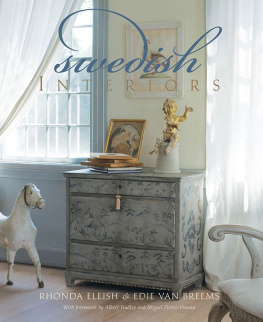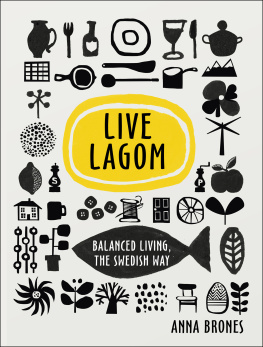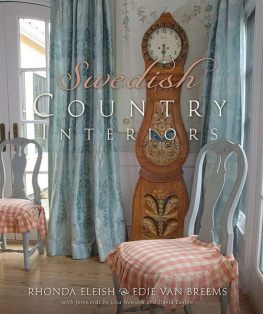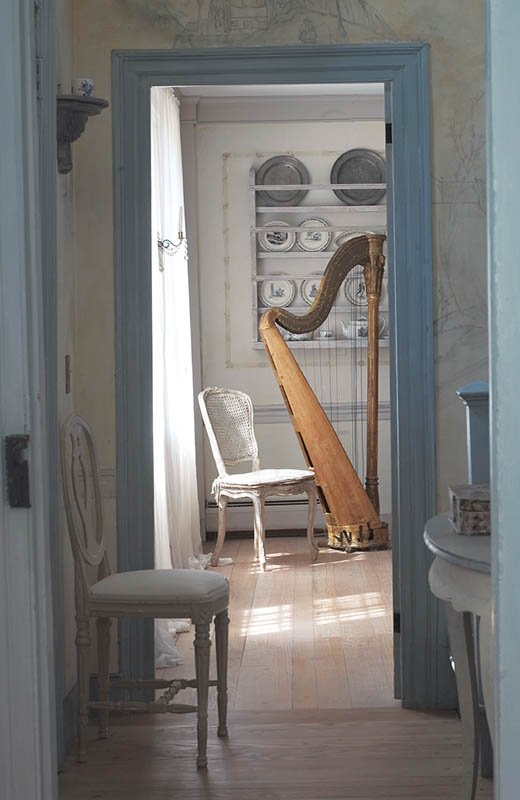Swedish Interiors
Rhonda Eleish & Edie Bernhard van Breems
Photographs by Jon E. Monson and L. Langdon Ergmann

Swedish Interiors
Digital Edition 1.0
Text 2013 Rhonda Eleish and Edie Bernhard van Breems
Photographs 2013 Jon E. Monson and L. Langdon Ergmann
All rights reserved. No part of this book may be reproduced by any means whatsoever without written permission from the publisher, except brief portions quoted for purpose of review.
Gibbs Smith
P.O. Box 667
Layton, Utah 84041
Orders: 1.800.835.4993
www.gibbs-smith.com
ISBN: 978-1-4236-1395-4
I dedicate this book to my parents, Cathy and G. Eleish, and my daughter, Kari. R.E.
A book for my two Northern Lights, Lars and Martin. E.B.v.B.
Foreword
Miguel Flores-Vianna
My father specialized as an orthopedic surgeon at the Karolinska Institute in Stockholm. From an early age, I heard stories at home about the wonderful country of Swedenof long summer days and endless winter snows. It was perhaps not a coincidence that I visited Sweden two months after Papas death. I remember the first day in Stockholm walking around in a daze, looking for the faces that, I imagined, had known my father. Little did I know that his memories of that country would become my own as I got to know that wondrous land.
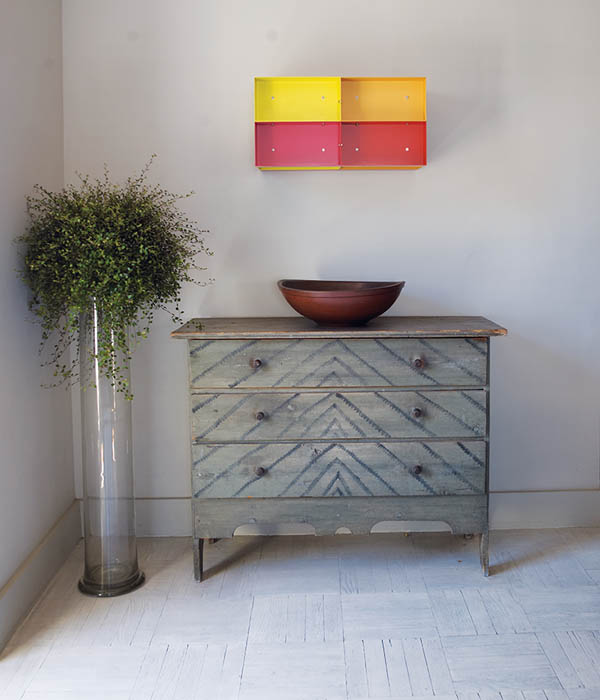
The strong lines on an early-nineteenth-century, blue-painted Swedish chest of drawers are juxtaposed with the lines of the primary-colored wall sculpture by American artist Donald Judd.
The world had changed a great deal by the time of my arrival in Sweden. My fathers Sweden was quintessentially the 1960s, full of social exploration, of new boundaries and possibilitiesSweden was then at the forefront of all that. My world was the 1990s, and the Sweden that I came to know and love was very different.
My profession as a New York magazine editor had brought me to the country in search of beautiful architecture, inspiring interiors, and a very definitive sense of design. My various visits to Sweden, thereafter, and my meetings with members of the Swedish design communities, increasingly gave me a deep appreciation for how the citizens of that country view spaces that they inhabit in their daily liveswhether their home spaces are guided by principles of the eighteenth century or the twenty-first. Throughout that land, there is an appreciation for space, light, certain types of color, noble materials, and surroundings that I have not often seen in other countries. The Swedes are at ease with the world, and their homes are a microcosm of the world as they see it: elegant and simplewhether traditional or contemporaryalways unpretentious, warm and well lived. These characteristics are well understood and admired by their American cousins. I always say, in fact, that our country speaks English, but in its love for equality and freedom, it is a Scandinavian nation at heart.
The houses in these pages are American homes that have tried to capture the essence of their Scandinavian counterparts. This is a first in American book publishing, and it is no surprise to me that my friends Edie van Breems and Rhonda Eleish have authored it. Their work as antiques dealers specializing in Swedish eighteenth- and nineteenth-century furnishings has made them not only experts in design, but has given them a deep understanding of how and why Sweden has influenced the American home. I hope you will enjoy these pages as much as I did, and if this is your first encounter with Swedish design, may this be the beginning of a long love affair!
Skl!
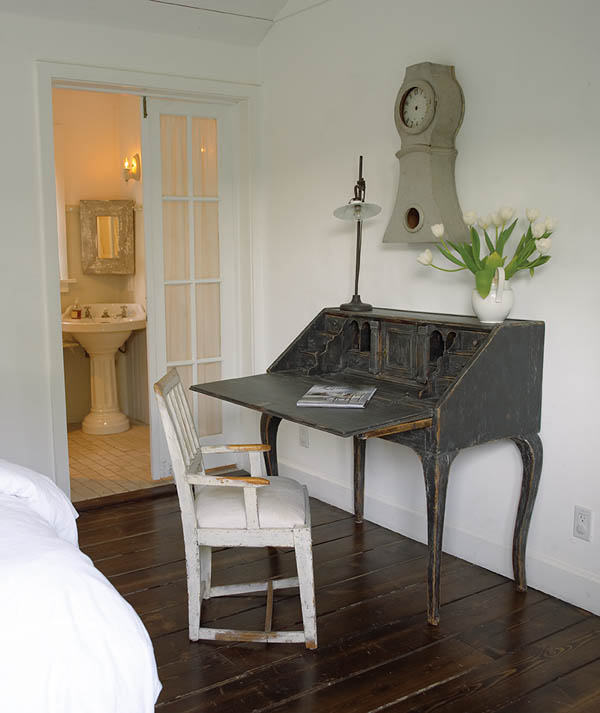
During the mid-eighteenth century, trade with the Far East was made accessible thanks to the established Swedish East Indian Company based out of Gteborg, Sweden. As a result, the Swedish aristocracy and wealthy merchant class commissioned furniture that mimicked elements borrowed from the fashionable Far East. Unable to afford the expensive lacquer finishes of their Asian counterparts, the Swedes relied on faux paint finishes to achieve a similar result. Linda and Lindsay Kennedys eighteenth century, black-painted Rococo writing desk represents an ideal example from this period.
Foreword
Albert Hadley
When one thinks of Swedish design and decoration, one conjures in ones mind and imagination visions of aristocratic and sophisticated examples that have been beautifully featured in such various publications as Neoclassism in the North by Hkan Groth, The Swedish Room by Lars and Ursula Sjberg, The Swedish House by Lars Sjberg, and other equally fine publications. The images that have been presented represent Swedish design in its full-blown splendora unique splendor of a given time and place. There is no denying the superb quality and cool allure afforded by such imagesimages that represent a total philosophy and a point of view of people whose lives are rich in historical investigation and interpretation. For the most part, it is architecture and design of august measure, and measure that causes one to return to a dream state without further pursuit of possibilities in the realm of personal expression.
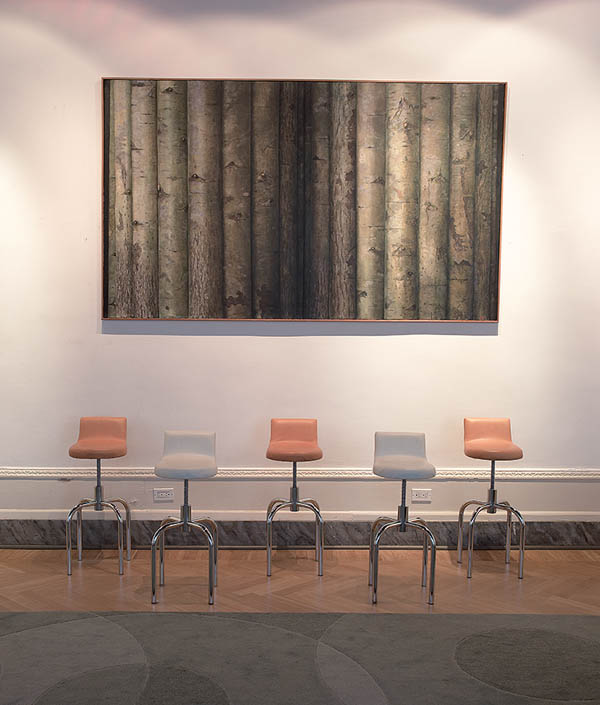
In the reception hall of the residence of the Swedish Consul General, New York, a set of five Kassorskestolar (cashiers chairs) designed by G. Asplund for Svenskt Tenn, circa 1929, are set dramatically under a painting of birch trees by acclaimed Swedish still-life artist Phillip von Schantz (192898).
Swedish Interiors opens wide the doors of possibilities for personal dreams and investigation. In this extraordinary book by Edie van Breems and Rhonda Eleish, one is enchanted, and yes, a bit surprised, by the multitude of examples put forth through means of photographic magic that show Swedish design in all its charm and beauty, very much at home in American houses.
In this ravishing volume, one visits vicariously a wide range of distinctive and personal houses where their owners have combined elements representative of their own personal taste; in each case, a taste that is diverse while at the same time expressing a strong and knowledgeable aesthetic.
Swedish Interiors comes full round: for instance, in an old log house where the interior walls are indeed the logs themselves, the furnishings are of appropriate earthiness and primitive quality. One is happily surprised to find ravishing examples of primitive Swedish furnishings and appointments performing with stage assurance alongside their American counterparts.
Another brilliant example is a house of more open plan employing soaring walls of multipaned glassthe spaces artfully punctuated by furnishings and objects of both Swedish and American design.
Edie van Breems and Rhonda Eleish offer the reader a great opportunity to witness these various and many properties where the inhabitantsobviously people with imagination and daringshare with enthusiasm and hospitality their superb examples of Swedish design in America.

